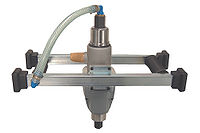Difference between revisions of "Pneumatic Mixers"
(Created page with "Category:Mixing{{Knoppen}} <noinclude><!------------------------------------------------ * READ THIS FIRST * Only edit this page if you can improve the content. * Improper u...") |
PurplePen19 (talk | contribs) |
||
| Line 7: | Line 7: | ||
* Please start editing this page after the /noinclude | * Please start editing this page after the /noinclude | ||
* -------------------------------------------------></noinclude> | * -------------------------------------------------></noinclude> | ||
This | [[File:Pneumatic Mixers.jpg|thumb|200px|right|Pneumatic Mixers]] | ||
'''Pneumatic Mixers''' are mixers that use compressed gas to perform a variety of tasks. Some Pneumatic Mixers systems can take in and compress air from the outside, and other systems rely on tanks of compressed gas of a different composition. | |||
==Pneumatic Process== | |||
This pneumatic process generally occurs in two stages. In the first stage, the gas is compressed. When air is the gas being used, the system is designed to take in air, compress it, and pump it into some type of holding pump or tank. When a different gas is being used, then it is usually compressed at a factory and sent on in tanks. The compressor then releases this compressed gas into a carefully constricted series of valves and pumps, where it pushes against opposing forces and does work. In pneumatic drills, the gas pressure drives the drill down, while in pneumatic motors the pressure helps to pump pistons. | |||
==Common Types== | |||
*[[Pharmaceutical Mixers]] | |||
*[[Laboratory Mixers]] | |||
*[[Bung Mixers]] | |||
==Applications== | |||
These are commonly used for mixing paint, glue, epoxy, mortar, concrete, refractory cement and other materials in shipyards and the oil and gas industries. They can be used around water with no fear of shock or blown circuitry. | |||
==Video== | |||
<youtube>H1I6sWnXORg</youtube> | |||
Latest revision as of 08:23, 31 August 2012
Pneumatic Mixers are mixers that use compressed gas to perform a variety of tasks. Some Pneumatic Mixers systems can take in and compress air from the outside, and other systems rely on tanks of compressed gas of a different composition.
Pneumatic Process
This pneumatic process generally occurs in two stages. In the first stage, the gas is compressed. When air is the gas being used, the system is designed to take in air, compress it, and pump it into some type of holding pump or tank. When a different gas is being used, then it is usually compressed at a factory and sent on in tanks. The compressor then releases this compressed gas into a carefully constricted series of valves and pumps, where it pushes against opposing forces and does work. In pneumatic drills, the gas pressure drives the drill down, while in pneumatic motors the pressure helps to pump pistons.
Common Types
Applications
These are commonly used for mixing paint, glue, epoxy, mortar, concrete, refractory cement and other materials in shipyards and the oil and gas industries. They can be used around water with no fear of shock or blown circuitry.
Video
